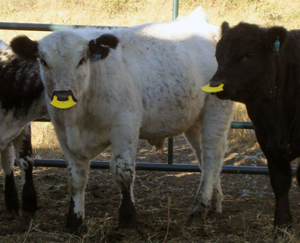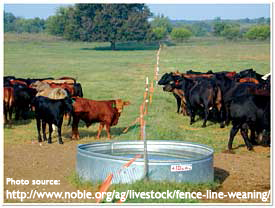Try These Weaning Techniques for More Productive Calves this Fall
It won’t be long before it’s time to wean calves so that cows can head into winter in good body condition. The abrupt separation of calves from their dams is the most common approach to weaning, but it’s also the most stressful, and calves that experience a lot of stress underperform.
It’s easy to see why weaning is stressful on calves; sudden deprivation of milk and social contact with mothers, being handled for vaccinations, changes to feed and water sources, and transportation to a different environment with unfamiliar pen mates is a lot for young animals to cope with. The stress calves experience through weaning depresses their immune systems, making freshly weaned calves the most susceptible to bovine respiratory disease (BRD) infections. Stressed calves also have lower feed intakes. Listening to their bawling, seeing them pace in their pens and dealing with sick calves is no doubt stressful on producers too.
This article outlines some ideas to keep stress at a minimum during weaning. Understanding the principle of low-stress weaning allows producers to wean calves in whatever ways work best on their operation while enjoying the benefits of reduced incidence of disease in calves, reduced costs and time spent on treatments, better weight gain, and a quieter barnyard.
Low-stress management ideas are not only relevant to those who retain ownership of fed calves. For producers that sell direct to backgrounders or feedlots, practicing low-stress techniques can help build a reputation for content, healthy, high-preforming calves worth a premium.
Minimizing stress during weaning is not only more profitable in the long-run for cattle producers, it is also attractive to consumers. Consumers are increasingly concerned about the welfare of livestock and the use of antimicrobials. Low-stress weaning techniques are key to good welfare and disease prevention in freshly weaned calves, thereby reducing the need for antibiotic treatments.
The Code of Practice for the Care and Handling of Beef Cattle recommends developing a weaning strategy that minimizes stress, such as two-stage or fence-line weaning. These practical weaning methods more closely imitate the natural weaning process where a cow rejects a calf’s attempts to nurse.
Two-stage weaning

In Stage 1, calves wear anti-suckling nose-tags. The nose-tags allow the calves to stay with their dams, but stop them from nursing. Calves wear the nose-tags for about 4-5 days and the nose-flaps are removed before the calves’ noses get sore. When the nose-tags are removed, the calves are also separated from the dams, i.e. Stage 2. This weaning method requires an extra trip through the chute.
Research by Dr. Derek Haley, a veterinarian and assistant professor at the Ontario Veterinary College in Guelph, found that calves that underwent two-stage weaning with anti-suckling nose-tags vocalized 97% less, spent 30% more time eating, and walked 73 kilometers less than their abruptly weaned counterparts. In addition, the dams of the two-stage weaning calves vocalized 84% less.
Learn more of two-stage weaning, see how to put nose-tags in calves and hear from producers that have tried this method in this excellent 5 minute video produced by and featuring Dr. Joseph Stookey, a researcher of animal behaviour and cattle handling at the University of Saskatchewan.
Fence-line weaning

Fence-line weaning is nearly as effective as two-stage weaning at reducing signs of stress. With this method, cows and calves are separated by a fence but can still see, hear, and smell one another, and preferably also have nose-to-nose contact. Dr. Haley’s research found that calves that were fence-line weaned vocalized 50% less, walked less, and had higher weight gains in the first 10 weeks after separation than abruptly weaned calves.
There are a number of ways to set up a fence-line weaning program depending on a producer’s existing facilities. Regardless of the details, cows and calves should be kept apart for at least 3-4 days and fencing must be sturdy. Page wire or 6 strands of barbed wire may be necessary to keep calves from getting back with their mothers. If calves are familiar with electric fencing, 2-3 strands of electric wire may be enough.
Dr. Henry McCarthy, a practicing veterinarian and cow-calf producer from Wawota, Saskatchewan has been observing the benefits of various quiet weaning techniques for over 20 years and uses fence-line weaning with his own cattle. His experience is that calves weaned using low-stress practices have a treatment rate of only 5-10%, instead of the 25-30% seen in abruptly weaned calves. (Hear more from Dr. McCarthy in videos on his website.)
There are a number of ways to set up fence-line weaning, such as:
- In the pasture, lock the cows in the corrals and leave the calves loose in the environment that they are familiar with
- Set up page wire in the pasture and sort cows from calves onto either side
- Separate cows into a neighboring lot
Quiet cattle handling
Practicing quiet handling methods, including loading and unloading trailers, is key. When handlers are quiet and move carefully in well-designed facilities, cattle remain calm. A stressful handling experience while weaning calves can undo the benefits you would have seen otherwise seen by using low-stress techniques.
This 1.5 minute video shows an easy, low-stress method of separating cow-calf pairs. It was produced by Dr. Joseph Stookey.
For good tips on how to modify existing handling facilities to reduce stress on cattle, watch this video featuring Dr. Temple Grandin, designer of livestock handling facilities and a Professor of Animal Science at Colorado State University.
Gradually transition calves onto new feed
Make feed and water sources available to calves before they are separated from their dams. That way calves will already have learned where to find feed and water once their dams are removed.
Perform other stressful events at another time
The number of stressors animals experience at a time should be limited as much as possible. Castration, dehorning, branding and initial vaccinations should all be done well in advance of weaning. If possible, save the second round of vaccinations until after weaning. Veterinarian Dr. McCarthy admits that giving boosters 4-6 weeks after weaning “sounds bonkers” but insists that it works.
When possible, move the cows instead of the calves
Being transported or moved to a new environment is stressful on calves so when possible, allow the calves to stay in their familiar environment and move the dams. Older cattle are better able to cope and have fewer sources of stress during weaning compared to the calves.
Editor’s note: This article is in part adapted from beefresearch.ca/blog/reducing-weaning-stress/ and beefresearch.ca/blog/reducing-weaning-stress-part-2-improving-profits/
Click here to subscribe to the BCRC Blog and receive email notifications when new content is posted.
The sharing or reprinting of BCRC Blog articles is welcome and encouraged. Please provide acknowledgement to the Beef Cattle Research Council, list the website address, www.BeefResearch.ca, and let us know you chose to share the article by emailing us at info@beefresearch.ca.
We welcome your questions, comments and suggestions. Contact us directly at info@beefresearch.ca or generate public discussion by posting your thoughts below.